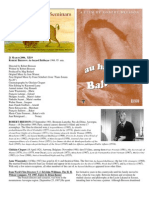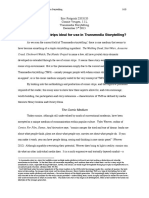0 ratings0% found this document useful (0 votes)
595 viewsWes Anderson: His Approach and Philosophy To Filmmaking
Wes Anderson: His Approach and Philosophy To Filmmaking
Uploaded by
rnelsonchowThis document discusses differing perspectives on Wes Anderson's unique approach to filmmaking. Some praise his ability to distill complex emotions into simplified yet representative fictional worlds. However, others criticize that his minimalist style ignores important historical and cultural contexts. Supporters counter that focusing only on the essential emotional elements allows Anderson to more powerfully convey feelings. Debates also consider Anderson's emphasis on constructed singular locations, which some argue diminish real settings but others see as intentionally imagined spaces that manifest character psychology.
Copyright:
© All Rights Reserved
Available Formats
Download as PDF, TXT or read online from Scribd
Wes Anderson: His Approach and Philosophy To Filmmaking
Wes Anderson: His Approach and Philosophy To Filmmaking
Uploaded by
rnelsonchow0 ratings0% found this document useful (0 votes)
595 views2 pagesThis document discusses differing perspectives on Wes Anderson's unique approach to filmmaking. Some praise his ability to distill complex emotions into simplified yet representative fictional worlds. However, others criticize that his minimalist style ignores important historical and cultural contexts. Supporters counter that focusing only on the essential emotional elements allows Anderson to more powerfully convey feelings. Debates also consider Anderson's emphasis on constructed singular locations, which some argue diminish real settings but others see as intentionally imagined spaces that manifest character psychology.
Original Description:
Wes Anderson creates simplified, unrealistic worlds which his films inhabit.
Original Title
Wes Anderson: His approach and philosophy to filmmaking
Copyright
© © All Rights Reserved
Available Formats
PDF, TXT or read online from Scribd
Share this document
Did you find this document useful?
Is this content inappropriate?
This document discusses differing perspectives on Wes Anderson's unique approach to filmmaking. Some praise his ability to distill complex emotions into simplified yet representative fictional worlds. However, others criticize that his minimalist style ignores important historical and cultural contexts. Supporters counter that focusing only on the essential emotional elements allows Anderson to more powerfully convey feelings. Debates also consider Anderson's emphasis on constructed singular locations, which some argue diminish real settings but others see as intentionally imagined spaces that manifest character psychology.
Copyright:
© All Rights Reserved
Available Formats
Download as PDF, TXT or read online from Scribd
Download as pdf or txt
0 ratings0% found this document useful (0 votes)
595 views2 pagesWes Anderson: His Approach and Philosophy To Filmmaking
Wes Anderson: His Approach and Philosophy To Filmmaking
Uploaded by
rnelsonchowThis document discusses differing perspectives on Wes Anderson's unique approach to filmmaking. Some praise his ability to distill complex emotions into simplified yet representative fictional worlds. However, others criticize that his minimalist style ignores important historical and cultural contexts. Supporters counter that focusing only on the essential emotional elements allows Anderson to more powerfully convey feelings. Debates also consider Anderson's emphasis on constructed singular locations, which some argue diminish real settings but others see as intentionally imagined spaces that manifest character psychology.
Copyright:
© All Rights Reserved
Available Formats
Download as PDF, TXT or read online from Scribd
Download as pdf or txt
You are on page 1of 2
I.
Research on Wes Anderson: His approach and philosophy to lmmaking
Nearly all the authors who write about Wes Anderson, whether they view him positively
or negatively, remark on his unique ability to create a miniature version of the world that
is somewhat removed from reality. In this world, he has complete control, creating
characters that while perhaps are simple, also reveal basic truths that are
representative of the real world.
Michael Chabon praises this quality in his article The Film Worlds of Wes Anderson,
writing that all art is a distilled version of a piece of the world. The best works of art are
able to be faithful maps, accurate scale models, of this beautiful and broken world. But
while Andersons work may only be a model of something more real, it is not without
gravity. Chabon writes that Andersons miniatures span continents and decades. They
comprise crime, adultery, brutality, suicide, the death of a parent, the drowning of a
child, moments of profound joy and transcendence. Anderson is able to take the
emotions that occur in real life and apply them to simplied, ctional situations,
situations that are carefully crafted for the sole purpose of conveying that emotion, that
one thought, that feeling.
Brendan Kredell views Anderson differently, and thinks that his simplicity is in fact an
oversimplication. In his article Wes Anderson and the City Spaces of Indie Cinema,
Kredell argues that Anderson typies the attitude of the urban gentrifying class that
rose to prominence during the end of the twentieth century and the beginning of the
twenty-rst. He believes that these gentriers ignore history and culture to their
detriment, extracting only supercial qualities from cultures that they mine. The
cinematic city is abstracted and aestheticized, presented to the viewer as a
romanticized and essentialized space rather than an organic environment inhabited by
real people, he writes. The city is abstracted in the name of an urban lifestyle that
casually (and sometimes willfully) ignores the historical and cultural specicities of the
neighborhoods that it transforms. It is certainly easy to see how one could take this
view; Anderson does purposefully leave out a lot of details about the context of his lms.
But perhaps this is the point: in making a model of the world, one cannot then but back
every realistic detail into the model. In order to clearly and accurately convey the
feelings that Chabon describes, maybe some things are better left out, and maybe
these things include cultural and historical details that ultimately have no bearing on the
story.
Chabon addresses this point, writing that the world in its realistic state is too large of a
scope for a lm to handle. Grief, at full scale, is too big for us to take it in; it literally
cannot be comprehended, he writes. But distance does not ought not necessarily
imply a withdrawal With each of his lms, Andersons total command of detail both
the physical detail of his sets and costumes, and the emotional detail of the uniformly
beautiful performances he elicits from his actors has enabled him to increase the
persuasiveness of his own family Zemblas, without sacricing any of the paradoxical
emotional power that distance affords. Chabon sees Andersons ignoring of selected
contextual elements as a positive, a tool that allows him to create more powerful,
specic work, and that the addition of precise details is the way he makes up for the
lack of more general information in the lm.
In addition to Andersons philosophy and framing of his lms, there is also debate about
the role of architecture in them. Anderson tends to zero in on one location, whether it is
a hotel, boat, school, or private home, and much of the action occurs in this place.
Kredell once again takes issue with this, arguing that the focus of the singular location
diminishes the power of history and culture that a realistic neighborhood affords:
Anderson prevents the city from its own identity, choosing instead to treat it as a
location within which to construct his own social universe. However, many lms do
this perhaps shooting in one city and labeling it as another and Kredell acknowledges
this. He takes special offense not to the fact that Anderson misconstrues the
surroundings, but that he almost completely ignores them: Anderson does not simply
shoot his lm in a house in Harlem and represent it instead as a location in Brooklyn, for
instance. Rather, he obliterates the very space of the house itself. He shoots in
Harlem, but his lm belongs to nowhere.
Once again, perhaps Kredell is missing the point. In his article Wes Anderson: The
Architectural Film-Maker, Steve Rose describes the careful consideration that
Anderson puts into these made-up locations of his. Anderson takes pains to show you
that he is not cheating Instead of edits, he prefers zooms, whip pans and especially
tracking shot.. They are not only demonstrations of his technical virtuosity, they also
reinforce the continuity of his painstakingly constructed lmic space. Andersons lms
do not belong to nowhere, as Kredell puts it. They belong to an imaginary place, a
place that Anderson has created, a place that is brought into being for the sole purpose
of supporting the lm. These places are not random, and this is why Anderson does not
want the implication that a site has interfering with them: they are just right as they are,
as he imagined them, as he designed them. Rose writes of him: Liberated from the
constraints of function, Anderson can use architecture to manifest psychology. The
places that were constructed manifest the psychology of the characters in the lm, the
characters that Anderson created. It follows naturally that if he created the characters,
only he should know of the place that brings out their most important qualities as well.
You might also like
- The Wes Anderson CollectionDocument305 pagesThe Wes Anderson Collectionzoomonta86_688690471100% (2)
- The three amigos: The transnational filmmaking of Guillermo del Toro, Alejandro González Iñárritu, and Alfonso CuarónFrom EverandThe three amigos: The transnational filmmaking of Guillermo del Toro, Alejandro González Iñárritu, and Alfonso CuarónNo ratings yet
- E46 Trouble CodesDocument15 pagesE46 Trouble CodesAndreea Filip78% (9)
- Aardman Animations Beyond Stop-Motion (Annabelle Honess Roe)Document289 pagesAardman Animations Beyond Stop-Motion (Annabelle Honess Roe)Filipe PintoNo ratings yet
- Swat Codes Worksheet Roads EndDocument1 pageSwat Codes Worksheet Roads Endapi-389332633No ratings yet
- Moonrise KingdomDocument102 pagesMoonrise KingdomAndreas SundgrenNo ratings yet
- Bordwell NarrationDocument22 pagesBordwell NarrationRoozbeh PNo ratings yet
- Stop The Clocks Time and Narrative in Cinema - CompressDocument191 pagesStop The Clocks Time and Narrative in Cinema - CompressLed Media PlusNo ratings yet
- ScriptwritingDocument4 pagesScriptwritingRobert GrangeNo ratings yet
- BalthazarDocument10 pagesBalthazarAgustina Costa VarsiNo ratings yet
- 25 Books For CinematographersDocument1 page25 Books For CinematographersNandan KumarNo ratings yet
- The Lure of the Image: Epistemic Fantasies of the Moving CameraFrom EverandThe Lure of the Image: Epistemic Fantasies of the Moving CameraNo ratings yet
- Neuropsychopharmacology The Fifth Generation of Progress: 5th EditionDocument2,054 pagesNeuropsychopharmacology The Fifth Generation of Progress: 5th Editiondanilomarandola100% (1)
- Comics and Transmedia Storytelling - Eri PDFDocument10 pagesComics and Transmedia Storytelling - Eri PDFAna Javier100% (1)
- Themes and Stories: Wes AndersonDocument2 pagesThemes and Stories: Wes AndersonAmy MarsNo ratings yet
- Wes AndersonDocument10 pagesWes AndersonIgna BNo ratings yet
- Isle of Dogs-Wes Anderson PDFDocument20 pagesIsle of Dogs-Wes Anderson PDFCarolina ArboledaNo ratings yet
- Wes Anderson PresentationDocument16 pagesWes Anderson PresentationAna BeatrizNo ratings yet
- Nikolai Gogol - The OvercoatDocument18 pagesNikolai Gogol - The OvercoatnikkibeelovedNo ratings yet
- History of FilmDocument15 pagesHistory of FilmJauhari Alfan100% (1)
- An Introduction To Wes AndersonDocument3 pagesAn Introduction To Wes AndersonZafira NadyaNo ratings yet
- Art Cinema - Narration Breaking Down A Wayward ParadigmDocument13 pagesArt Cinema - Narration Breaking Down A Wayward Paradigmsolodudas100% (1)
- Chris Marker Talks About Hitchcock's VertigoDocument8 pagesChris Marker Talks About Hitchcock's VertigoLuís Flores100% (1)
- Haifaa Al MansourDocument1 pageHaifaa Al MansouralexanderbisleyNo ratings yet
- An Interview With Robert MckeeDocument7 pagesAn Interview With Robert MckeesavonefNo ratings yet
- Watership DownDocument265 pagesWatership Downmarwagh99No ratings yet
- Essential Brakhage Selected Writings On PDFDocument85 pagesEssential Brakhage Selected Writings On PDFigorNo ratings yet
- Elia LevitaDocument9 pagesElia LevitaManuel PhillipsNo ratings yet
- Animating Gender Roles - How Disney Is Redefining The Modern Princess PDFDocument5 pagesAnimating Gender Roles - How Disney Is Redefining The Modern Princess PDFXander ClockNo ratings yet
- Inside The Wes Anderson UniverseDocument7 pagesInside The Wes Anderson Universeapi-317250740No ratings yet
- Dudley Andrew Film TheoryDocument11 pagesDudley Andrew Film Theoryasslii_83No ratings yet
- Chatman Seymour - What Novels Can Do That Films Can't (And Vice Versa)Document18 pagesChatman Seymour - What Novels Can Do That Films Can't (And Vice Versa)David SalazarNo ratings yet
- The Hotel KracauerDocument19 pagesThe Hotel KracauerrequisiteshizzleNo ratings yet
- Gledhill On NotoriousDocument17 pagesGledhill On NotoriousBrian Smith100% (2)
- Running Head: The King of UniqueDocument10 pagesRunning Head: The King of UniqueAndrew MegaNo ratings yet
- Bord Well NarrationDocument23 pagesBord Well NarrationCatalina LeahuNo ratings yet
- Author George Saunders BiographyDocument3 pagesAuthor George Saunders BiographyNisha Sharma100% (1)
- Andrei Tarkovski The Sacrifice 1986 AnalysisDocument13 pagesAndrei Tarkovski The Sacrifice 1986 AnalysisMohannad HassanNo ratings yet
- Paul Thomas Anderson Director StudyDocument2 pagesPaul Thomas Anderson Director StudyJordan SchwarzenbergerNo ratings yet
- PlotDocument10 pagesPlotBishal Ghosh0% (1)
- Christian METZ - The Modern Cinema and NarrativityDocument22 pagesChristian METZ - The Modern Cinema and NarrativityGabrielle LoweNo ratings yet
- The Political Philosophy of Toy Story 3Document2 pagesThe Political Philosophy of Toy Story 3Atleta SovieticaNo ratings yet
- The Evolution of The Language of CinemaDocument14 pagesThe Evolution of The Language of CinemaIhjas AslamNo ratings yet
- Director Jaques TatiDocument1 pageDirector Jaques TatiBerin ÇubukçuoğluNo ratings yet
- Mulholland Drive and PostmodernismDocument3 pagesMulholland Drive and PostmodernismOdette BrownNo ratings yet
- Ria Thanouli, Post-Classical NarrationDocument15 pagesRia Thanouli, Post-Classical NarrationmentamentaNo ratings yet
- Micheal Henake & The Art of Screenwriting NoDocument11 pagesMicheal Henake & The Art of Screenwriting Nogetdipankar_10No ratings yet
- Blade Runner RevDocument22 pagesBlade Runner RevEdson F. OkudaNo ratings yet
- Alfred Hitchcock Comparison of 4 MoviesDocument1 pageAlfred Hitchcock Comparison of 4 MoviessingingmanNo ratings yet
- Kurosawa On ScriptsDocument6 pagesKurosawa On Scriptsstefanos100% (1)
- BiopicDocument5 pagesBiopicUdhav NaigNo ratings yet
- Alfred Hitch Cock. Filming Our FearsDocument161 pagesAlfred Hitch Cock. Filming Our Fearsjameschisholm100% (3)
- Early Film,: Its Spedator and The Avant-GardeDocument4 pagesEarly Film,: Its Spedator and The Avant-GardeiRagpickerNo ratings yet
- Andrew Sarris Vs Pauline Kael Over Citizen KaneDocument2 pagesAndrew Sarris Vs Pauline Kael Over Citizen Kanealonso ruvalcaba100% (1)
- Lem Dobbs InterviewDocument105 pagesLem Dobbs InterviewCharlie ConwayNo ratings yet
- Modes of DocumentaryDocument10 pagesModes of Documentaryapc108No ratings yet
- Henry Jenkins AUDIENCES, POACHING AND PARTICIPATORY CULTURE ResumenDocument2 pagesHenry Jenkins AUDIENCES, POACHING AND PARTICIPATORY CULTURE Resumenabenasayag100% (1)
- After Kieślowski: The Legacy of Krzysztof KieslowskiFrom EverandAfter Kieślowski: The Legacy of Krzysztof KieslowskiSteven WoodwardNo ratings yet
- READ - Neil CohnDocument11 pagesREAD - Neil CohnpepeNo ratings yet
- English: Quarter 4, Module 6 Analytical Listening To Make Predictions and ProjectionsDocument23 pagesEnglish: Quarter 4, Module 6 Analytical Listening To Make Predictions and ProjectionsEstelle Nica Marie DunlaoNo ratings yet
- Advanced Reservoir EngineeringDocument1 pageAdvanced Reservoir Engineeringpatrick KOUASSINo ratings yet
- Daily Follow Up - ReportDocument392 pagesDaily Follow Up - ReportDevasyrucNo ratings yet
- Richards Philosophy of RhetoricDocument72 pagesRichards Philosophy of RhetoricMarcelo Formiga100% (4)
- Cambridge International AS & A Level: Chemistry 9701/36Document10 pagesCambridge International AS & A Level: Chemistry 9701/36PikoNo ratings yet
- The Anthropology of Mining: Esource ARSDocument29 pagesThe Anthropology of Mining: Esource ARSEsteban RozoNo ratings yet
- Environmental Democracy in CameroonDocument98 pagesEnvironmental Democracy in CameroonPASTOR STARNo ratings yet
- Assess: How Healthy Are You?Document4 pagesAssess: How Healthy Are You?JohmNo ratings yet
- Microcontroller Based Heartbeat Monitoring With Display LCDDocument90 pagesMicrocontroller Based Heartbeat Monitoring With Display LCDRama Krishna M64% (14)
- Science 5 - Stars - Worksheet 1 - 4th QuarterDocument3 pagesScience 5 - Stars - Worksheet 1 - 4th QuartercharmaineNo ratings yet
- Edited - VLSI DESIGN U2-1Document20 pagesEdited - VLSI DESIGN U2-1merupuNo ratings yet
- 14 - FFT AssignmentDocument3 pages14 - FFT AssignmentMAHNOOR BARINo ratings yet
- LP - 2 - Eng - Elec1 - 2023 TranslationDocument6 pagesLP - 2 - Eng - Elec1 - 2023 TranslationGlezyl DestrizaNo ratings yet
- Experiment 3 (CMT200)Document4 pagesExperiment 3 (CMT200)hafiqahNo ratings yet
- Avengers Film WorksheetDocument4 pagesAvengers Film WorksheetThaynnara BarrosNo ratings yet
- Rimske Administrativne Jedinice Na Pretp PDFDocument66 pagesRimske Administrativne Jedinice Na Pretp PDFDženana Kahriman KurtovićNo ratings yet
- Jurnal Vibration Accelerometer With ArduinoDocument6 pagesJurnal Vibration Accelerometer With ArduinoilhamNo ratings yet
- I - S and Maths Grade 7 IDU Unit PlannerDocument9 pagesI - S and Maths Grade 7 IDU Unit PlannerYueping ShanNo ratings yet
- Grid Forming BESS Connection Fact SheetDocument5 pagesGrid Forming BESS Connection Fact SheetAlan ZorkotNo ratings yet
- Makaut Lab Exam Schedule, Even Sem, 2016Document5 pagesMakaut Lab Exam Schedule, Even Sem, 2016Soham ChaudhuriNo ratings yet
- Cross Flow Heat ExchangerDocument17 pagesCross Flow Heat Exchangerمالك كرجهNo ratings yet
- 1 - How To PDCA - Plan Do Check Act 20191019Document33 pages1 - How To PDCA - Plan Do Check Act 20191019Alpha Excellence consultingNo ratings yet
- Unit 8 Getting StartedDocument10 pagesUnit 8 Getting StartedTrân HoàngNo ratings yet
- Click Here: LAST UPDATE DATE ANF TIME: Wednesday, May 6, 2020 2:07:57 PMDocument6 pagesClick Here: LAST UPDATE DATE ANF TIME: Wednesday, May 6, 2020 2:07:57 PMRahul umaleNo ratings yet
- Business Intelligence and AnalyticsDocument2 pagesBusiness Intelligence and AnalyticsTHOR -No ratings yet
- Unit 1, LalatDocument14 pagesUnit 1, LalatAmelia MeiriskaNo ratings yet
- Sand Content Kit: Product InformationDocument4 pagesSand Content Kit: Product InformationPonchanon borahNo ratings yet

























































































